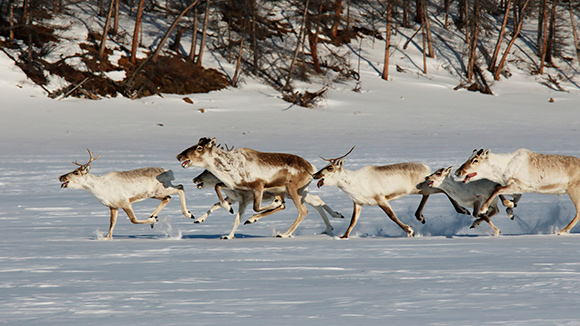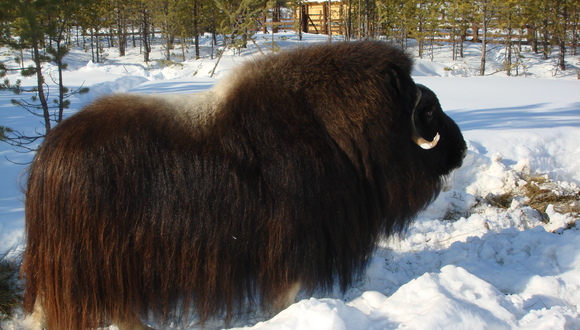How Diamonds are Protecting Siberia’s Reindeer

December 4th marks World Wildlife Conservation Day. As many of us decorate our homes with reindeer ornaments in the run-up to Christmas, we’re highlighting the work being done in Yakutia to ensure these «living diamonds» don’t fade into mythology.
As you enter Mirny, a remote mining town in north east Siberia, a statue commemorates its founding. It shows two geologists being guided by a local reindeer herder, an expedition that would lead to the discovery of diamond reserves, transforming the local area and making Russia the world’s largest producer of natural diamonds in the world today.
Decades after that first quest in the 1940s, the relationship between the diamond producers, the reindeer and the indigenous herders is a special one. ALROSA, the company behind the mining operations across Yakutia in Siberia, a vast but sparsely populated region partially encompassed in the Arctic circle, works closely with local authorities and communities to ensure protection of these magnificent creatures. December 4th marks World Wildlife Conservation Day, and, as many of us decorate our homes with reindeer ornaments in the run up to Christmas, we’re highlighting the work being done in Yakutia to ensure these «living diamonds» don’t fade into mythology.
There are approximately 146,000 wild reindeer (caribou) in Russia but they were placed on the International Union for Conservation of Nature’s red list of vulnerable plant and animal species in 2015, noting that the global population had declined 40% in less than 30 years. Threats include climate change, where the rise in temperature has caused the region’s perma-frost to thaw and release more greenhouse gasses, and poaching.
Mining activity, if not managed properly, is also a threat and something ALROSA takes very seriously. Safe crossing places have been integrated at its mining locations where reindeers are known to make their annual summer migrations and wildlife protection is written into policy. Alexander Fedorov, ALROSA’s deputy chief engineer for environmental protection, explains: «The Mining and Processing Division’s current procedures [ensure that] when scientists report that reindeers have entered the production area or started crossing the site access road, the division is brought to a standstill so as to ensure that reindeers pass freely through the industrial territory.»
Not only do they tailor their own operations to protect them, ALROSA is actively involved in efforts to conserve reindeer across the region. The Living Diamonds of Yakutia Natural Park is a 32,000 hectares conservation area founded in 2009 by local government and the mining company to preserve natural ecosystems, including reindeer. ALROSA has continued to fund the park ever since. Here the reindeer, along with yaks, bison, Yakut horses, elk, bears, peacocks, dogs and lynxes are free to live as if in the wild under the protection of the park’s eight staff.
One of the biggest challenges for conservationists is tracking the reindeer. Without it, the exact population figure and rate of decline is difficult to monitor. In 2016, ALROSA, along with one of the specialist institutes at the Siberian Branch of the Russian Academy of Sciences, pioneered the use of radio collars to track the movements of wild reindeer. The collars are put on the females in a heard as they lead the way during migration with their location fed back every 20 minutes. The reindeer can travel up to 400 miles during migration, one of the largest of any species. By placing between just 5 and 10 collars on these females each year, it’s possible to track the movement of around 15,000 reindeer. The collars are harmless to the reindeer and drop off once the battery runs out.
Tracking the reindeer in this way has enabled authorities to be alerted when they reach dangerous areas such as highways and mines. It has also highlighted the need for another specially protected natural area where wild reindeer give birth and raise their young which is currently in the works. The ALROSA-Rangifer Chekanovsky nature reserve will cover more than 64,000 hectares and help to ensure continued safe breeding for 84,000 wild reindeer, boosting the number of females in the herd to ensure sustainable stock numbers for the future. A completion date has yet to be announced but the project is in the process of being approved by the Yakutian government. Initiative will also help other endangered species in the area including musk ox, peregrine falcons and a number of plants.
These steps are vital to maintain biodiversity and support other plant and animal life in the area. «Without deer, the functioning of a holistic system will become impossible and degradation will ensue,» says Polina Anisimova, ALROSA’s chief ecologist. «Wild reindeer are a main component of existing interaction between animate and inanimate nature which forms the basis of the ecosystem of the Far North.»
«Deer is everything for us. As the Russian people used to have a horse, so for the inhabitants of Olenyok—a deer.»
Another part of this important eco-system is the domestic reindeer, on which many local people have relied for centuries. The reindeer provide transportation, food, clothing and tools for several groups of indigenous people and are ingrained in their way of life. «Deer is everything for us. As the Russian people used to have a horse, so for the inhabitants of Olenyok — a deer,» says Marina Nikolaeva, a reindeer herder and head of the department of agriculture for Olenyok Evenki National District, a rural locality in Yakutia.
The reindeer conservation efforts are a vital lifeline, not just for wildlife, but also the culture of the indigenous Evenks, Nenets and Yakuts. Marina grew up in a family of reindeer herders. One of her earliest childhood memories is drinking reindeer milk from a small herd belonging to her grandfather. «All our culture, our livelihood is connected with the reindeer. It’s part of our history, it is part of our tradition. It has been as such for years and years. Reindeer is primarily a friend for us,» Marina says.
In her role as head of the department of agriculture, her aim is to preserve this tradition and make it possible for young people to find work in reindeer herding, a career choice which remains popular despite urbanization trends. She considers ALROSA to be the local authority’s main partner in achieving this, citing their involvement with funding projects and sponsoring Reindeer Herder Day, an annual festival celebrating their culture.
The radio collars have also helped the herders. The mixing of wild and domestic reindeers can cause serious problems so herders are alerted if the wild species is nearby. Their arrival can put a strain on food resources and domesticated reindeers have been known to stray with wild herds, leaving the herders without a livelihood. Spreading of disease between the two herds is also a risk.
«We live, and seek harmony with nature. It is important to find the right balance between the wild and domesticated species.»
«We are nomadic people; we migrate with reindeer. We live, and seek harmony with nature. It is important to find the right balance between the wild and domesticated species,» Marina adds.
ALROSA’s support is vital to this balance and harmony which could see wild reindeer taken off the vulnerable species list and generations of herders supported for years to come. Nowhere is this more poetically represented than on Olenyok’s coat of arms: a reindeer with a diamond between its antlers. Until 70 years ago, these two hardly knew each other’s existence, with most diamonds existing deep below the reindeer’s feet. Now, they could be the key to their survival.
By Olivia Pinnock
